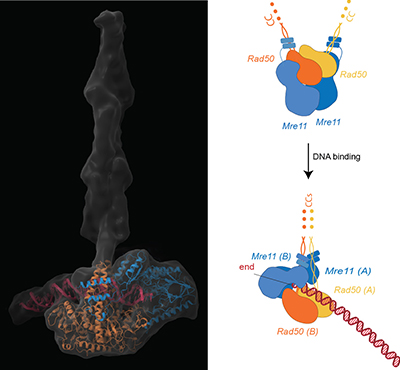DNA Repair
Opening the hatch to heal the break
02.09.2019
Karl-Peter Hopfner and his team have determined the structure of a key enzyme complex that is involved in DNA repair, and traced the cycle of conformational changes that it undergoes while performing its biochemical function.
 Various types of DNA damage can have serious repercussions, both for the individual cells in which they occur and for the organism as a whole. Instances of simultaneous breakage of both strands of the DNA helix are particularly harmful. Such double-strand breaks (DSBs) can be induced by radiation, as well as by environmental toxins, and can lead to cell death. However, cells possess efficient mechanisms for detecting and repairing DSBs. A molecular machine known as the MR complex plays a central role in this process. It recognizes and binds to DSBs, and initiates repair of the broken double helix. Karl-Peter Hopfner, Chair of Structural Molecular Biology at LMU’s Gene Center, and his team has now deciphered the complete three-dimensional structure of the MR complex and determined how it works. The new findings have just been published in the journal Molecular Cell.
Various types of DNA damage can have serious repercussions, both for the individual cells in which they occur and for the organism as a whole. Instances of simultaneous breakage of both strands of the DNA helix are particularly harmful. Such double-strand breaks (DSBs) can be induced by radiation, as well as by environmental toxins, and can lead to cell death. However, cells possess efficient mechanisms for detecting and repairing DSBs. A molecular machine known as the MR complex plays a central role in this process. It recognizes and binds to DSBs, and initiates repair of the broken double helix. Karl-Peter Hopfner, Chair of Structural Molecular Biology at LMU’s Gene Center, and his team has now deciphered the complete three-dimensional structure of the MR complex and determined how it works. The new findings have just been published in the journal Molecular Cell.
Figure: Structural model of the E. coli MR head complex fitted into the low resolution cryo-EM map with closed and elongated coiled-coils. Upon DNA binding, two main conformational changes occur. The Mre11 dimer (blue) moves to the side of the Rad50 dimer and the coiled-coils (CC, orange and yellow) close and clamp around the DNA (red). Source: L. Käshammer
For more information please visit LMU.de/news.
Original Publication:
Mechanism of DNA end sensing and processing by the Mre11-Rad50 complex.
Käshammer L, Saathoff JH, Lammens K, Gut F, Bartho J, Alt A, Kessler B, Hopfner KP
Molecular Cell 2019, September 03. DOI:https://doi.org/10.1016/j.molcel.2019.07.035

